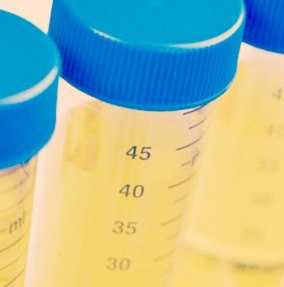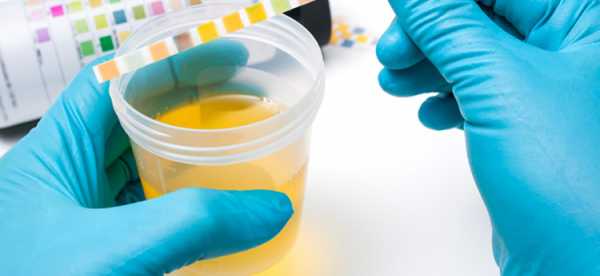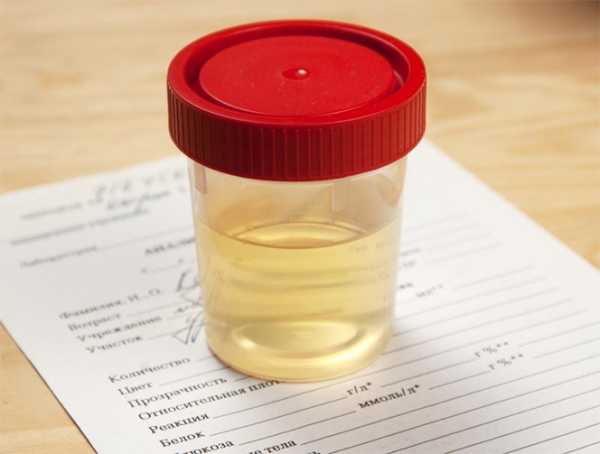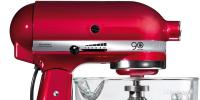Urine analysis according to Nechiporenko how much is done
Urinalysis of Nechiporenko is used to detect infection if abnormalities were detected in the clinical analysis of urine.
The analysis is carried out at: - latent inflammatory process in the kidneys and urinary tract; - hidden hematuria (blood in the urine); - monitoring the effectiveness of the treatment.
What preparation is needed for the study?
On the eve it is necessary to refrain from drinking alcohol, emotional and physical exertion, do not eat vegetables and fruits that can change the color of urine, do not take diuretics. It is not recommended to take a urine test within 5-7 days after cystoscopy and women during menstruation.
How to collect urine for research?
Before collecting urine, it is necessary to make a hygienic toilet of the external genitalia, then collect the middle portion of the morning urine, allocated immediately after sleep. To do this, the first amount of excreted urine (15-20 milliliters) is passed, and the middle portion of urine is placed in a prepared clean and dry container.
The collected urine should be delivered to the laboratory within 1-2 hours.
Urinalysis is prepared 1 working day.
What are the normal indicators of urine analysis according to Nechiporenko?
- leukocytes - up to 2000 in 1 ml;
- erythrocytes - up to 1000 in 1 ml;
- cylinders - up to 20 in 1 ml.
medportal.ru
Features of collecting a urine test according to Nechiporenko, preparation, results
Analysis of the composition of the patient's urine is one of the primary diagnostic tools that allows you to establish not only diseases of the kidneys and bladder, but also the state of the body as a whole. If the general study requires clarification, an additional urine test according to Nechiporenko is prescribed. The author of this method is a well-known surgeon, oncourologist, who saved hundreds of lives during the Patriotic War. The method he invented turned out to be more informative than those used previously, but at the same time very simple and fast. Currently, the Nechiporenko analysis is one of the most frequently prescribed studies. We will figure out how to pass it correctly and what violations can be found out from its results.
In what cases is it assigned
It is necessary to take a urine test according to Nechiporenko in the direction of a therapist, family doctor, specialists from the urological or nephrological department. This study is required when identifying deviations in the general analysis of urine, if there are discrepancies between the patient's complaints and the data of general analyzes, to determine the effectiveness of treatment and monitor the course of the disease in dynamics.
The main reasons for the appointment of an analysis according to Nechiporenko:
- Detection of damage to the kidney and ureter in urolithiasis.
- Monitoring the action of antibiotics in the treatment of bacterial infections.
- Determination of the presence of infections in the genitourinary organs, including chronic and sluggish.
- Diagnosis of kidney dysfunction due to injuries and diseases - vasculitis, diabetes mellitus, glomerulonephritis.
- Identification of the causes of painful urination, excessive or insufficient urine output during the day, frequent or too rare urges.
How is it different from other urine tests?
Urinalysis refers to screening methods, with its help it is possible to identify various pathologies. First, the entire collected portion of urine is examined to identify its physico-chemical characteristics. Secondly, using a microscope, the urine sediment is examined, the presence of bacteria, salts, blood elements and cylinders is counted in it - original casts of protein and cells that form in the tubules of the kidneys. As a result of the analysis, it will be indicated how many leukocytes and erythrocytes were found in the field of view, i.e. within the field of view of the microscope. Cylinders in quantitative terms are less frequently indicated. The most common result is “no cylinders found” or “single cylinders”, sometimes with an indication of their type.
Urinalysis according to Nechiporenko is considered a clarifying study. It is used to calculate how many erythrocytes, leukocytes and cylinders are in 1 ml of urine. The cylinders are sorted by composition, and the quantity of each type is indicated, which makes the diagnosis more accurate. This analysis is able to detect violations at the initial stage, which is especially important for pregnant women and young children. Therefore, they are prescribed an analysis of the collected urine according to the Nechiporenko method at the slightest doubt.
In case of kidney diseases, an analysis according to Zimnitsky is also prescribed. This is a study of the entire volume of urine in 24 hours without isolating its individual elements. By changes in the density and volume of urine after sleep and during wakefulness, a violation of the kidneys is judged.
How to collect urine for analysis according to Nechiporenko
For analysis, special containers are needed, on which there should be a mention of their sterility. They can be bought inexpensively at pharmacies. Glass and plastic food jars are not recommended, as dirt or traces of detergents on their walls can distort the results. Some laboratories allow the collection of urine only in their own containers, which are issued on the eve of the analysis against a small deposit.
It is correct to donate urine directly into the container, and not pour it from other containers. The exception is small children and bedridden patients. For them, you can use urinals, which are also purchased at the pharmacy.
 The basic rule for collecting urine is that only its middle portion should get into the jar. This means that the jet is directed into the toilet for the first 2 seconds, and only then the container is filled. The first drops of urine wash away dirt and epithelium from the perineum and urethra.
The basic rule for collecting urine is that only its middle portion should get into the jar. This means that the jet is directed into the toilet for the first 2 seconds, and only then the container is filled. The first drops of urine wash away dirt and epithelium from the perineum and urethra.
No matter how perfect hygiene is, it is impossible to avoid urine contamination, so the Nechiporenko analysis may be unreliable. The last portion of urine should not be in the jar, because it contains sediment from the bladder.
How much urine is needed for analysis depends on the condition of the patient. With normal health, 100 ml will be required. If it is impossible to collect this amount (for example, with frequent urination with cystitis), it is enough to pass 20 g of urine for analysis. Analysis can be performed even in the most difficult cases. If urine is not excreted, the hospital can take it with a catheter, even if only a few milliliters have accumulated in the bladder.
How to take a urine test - algorithm:
- Discuss with your doctor which medications you are taking may skew the result. Discontinue these drugs 2 days before the date of delivery.
- On the day before the test, exclude carbonated and alcoholic drinks, as well as food, dyes from which can pass into urine - beets, blueberries, carrots. The rest of the diet should be normal, without sudden changes.
- On the eve of urine collection, avoid strong physical exertion.
- At night before the analysis, refrain from sexual relations.
- In the evening, wash well with detergent, in the morning - repeat the toilet with clean water without soap. Women during menstruation need to use tampons and toilet even more thoroughly.
- Collect urine during the first urination after a night's sleep.
- Immediately deliver the container to the laboratory. The maximum storage time of the test liquid is no more than 1.5 hours. When delivering, avoid hypothermia of urine.
If you accurately follow all the points of this algorithm, the result of the analysis will be as reliable as possible.
Deciphering analysis and norms
The indicators below are considered the norm, both in men and in women and children, and regardless of the way urine is obtained - the usual collection in a container or taking it by medical manipulation directly from the renal pelvis.
What role do these elements play, and what processes in the body are signaled by their increase in urine:
Leukocytes
White cells that circulate in the blood vessels and, if necessary, penetrate into the extracellular space. Their main function is to protect the body from the penetration of foreign bodies. The maximum number of leukocytes accumulates in those places where immunity is needed. If the leukocytes in the decoding of the analysis are more than normal, it means that an infection has settled in the urinary system, and inflammation has occurred.

Urinalysis according to Nechiporenko in acute pyelonephritis shows a significant increase in leukocytes. With a 30-fold increase, we are talking about pyuria - the detection of pus in the urine. It consists mainly of dead leukocytes that could not cope with their task. This result of the study indicates a serious pathology that requires urgent treatment in a hospital.
The norm in children in terms of the number of leukocytes coincides with adults. Despite this, in children, analysis according to Nechiporenko often shows their elevated level. This is explained by the difficulties in maintaining hygiene, especially in the presence of diaper rash or allergic reactions, around which leukocytes accumulate.
red blood cells
Neighbors of leukocytes in the bloodstream. These are red cells that provide transport services in the body: they carry oxygen to tissues and return carbon dioxide from them to the lungs. Some red blood cells enter the urine through the filters of the glomeruli. If kidney function is impaired, the number of red blood cells in the urine increases greatly. Also, red blood cells can be detected when the urinary system is injured, inflammation along the path of urine from the kidney to the urethra. In women, false positive results occur when taking an analysis according to Nechiporenko during menstruation.
During pregnancy, an increase in the number of red blood cells occurs due to a change in the position of the kidneys - an enlarged uterus presses on them. This condition is fraught with stagnation of urine and inflammation, and therefore requires timely treatment.
cylinders
Formed in the tubules of the kidneys and in a minimal amount can enter the urine. In a healthy person, they should consist only of hyaline, a transparent dense protein from blood plasma; normally, only these cylinders are shown by a urine test according to Nechiporenko. If other types of cylinders are found in the urine, this indicates kidney damage, which leads to kidney failure. Hyaline casts in increased amounts may indicate proteinuria (protein excretion in the urine) or be the result of severe physical exertion.
What bad results can indicate
So, the numbers on the form are received, one of them exceeds the normal figure. Let's consider how to correctly interpret these data and what diseases can tell us about the presence of a urine test according to Nechiporenko.
| Item above normal | Possible violations | |
| Leukocytes | Inflammation in one of the organs on the path of urine: pyelonephritis, cystitis. Urolithiasis with accompanying inflammation. Prostatitis in men, vaginitis or endometritis in women. A small physiological growth - when adapting to the pregnancy that has arisen. | |
| red blood cells | Fresh | Inflammation of the urinary tract, trauma to the kidneys and urinary stones formed in them, injuries, neoplasms, hemophilia. |
| leached | Kidney damage by high blood pressure, toxic substances, glomerulonephritis. | |
| cylinders | hyaline | Acute and chronic kidney disease. Within the normal range - in the case of physiological proteinuria caused by prolonged hypothermia and overheating, physical fatigue. |
| Erythrocyte | Injury to the kidneys, the formation of blood clots in them, high pressure in the vessels, leading to damage to the renal tubules. | |
| grainy | Glomerulonephritis in the active phase, severe poisoning and intoxication, autoimmune diseases, extensive kidney infection. | |
| waxy | Severe kidney damage, fraught with their organic changes and renal failure. | |
| epithelial | Pathological process in the tubules of the kidneys, most often pyelonephritis or nephrosis. |
How much is a urine test according to Nechiporenko
This analysis is technically simple, the equipment for its implementation is available to all laboratories. How much analysis is done depends on the workload of the laboratory. You can usually get a printout the next business day. Some commercial establishments offer a 2-hour urine test for an additional fee. For terminal patients in a hospital setting, the analysis takes only a few minutes.
diabetiya.ru
Urinalysis according to Nechiporenko
Among the urine tests, the most common ones are distinguished: general urinalysis, according to Nechiporenko, according to Zimnitsky, according to Sulkovich, according to Amburg, etc. Each of these analyzes is done for a specific purpose, because the laboratory research methodology is slightly different.
In order to determine the number of erythrocytes, cylinders and leukocytes, an analysis is made according to Nechiporenko. Usually, such a need is prompted by deviations from normal indicators in the general analysis of urine, which requires additional research.
In addition, urinalysis indicators according to Nechiporenko can help in the diagnosis of inflammatory processes in the excretory system (cystitis, pyelonephritis), latent cylindruria and hematuria (when blood appears in the urine), leukocyturia. Also, the analysis is done when assessing the quality of treatment prescribed after the diagnosis of a particular disease.
In order to do a urine test according to Nechiporenko, you need an average morning portion that has been in the urinary tract for at least four hours. That is, it is ideal if the patient did not urinate during the night, and after sleep he collected urine for research. In order for the results to be correct, it is necessary to thoroughly wash the genitals before collection, otherwise the cells that naturally die off in a day may give distorted data. Urine should be collected in three containers, well washed and dried. Very little urine is needed in the first container, most of it should go to the second, and the collection ends in the third jar. The second portion is mixed and taken into a vacuum tube, which can be requested at a medical institution.
In order to properly fill the test tube, the urine is mixed with a special holder and, without removing it from the container, the lid of the vacuum tube is attached there, without removing it from the test tube itself. After pressing, the needle pierces the cap, and the test tube fills up on its own, then is removed from the holder. The collected urine must be delivered to the laboratory within 24 hours. If the patient has postoperative drainage, then it is taken through the valve and poured into a test tube.
Usually a urine test according to Nechiporenko is done from six to eight hours.
After its implementation, doctors evaluate the results. The number of leukocytes, which mainly fight infection in the body, should not be more than two thousand units per milliliter of urine. If the content of leukocytes is much higher, then this indicates that the excretory system is infected. Red blood cells in the body are responsible for delivering oxygen to the cells, so if they contain an excess amount (more than one thousand units per milliliter of urine), then this indicates the possible presence of tumors or other pathologies in the excretory system. Urinalysis according to Nechiporenko also evaluates the number of cylinders. Cylinders are proteins that take on their shape after passing through the renal tubules. In the urine of a healthy person, they should contain no more than twenty units per milliliter. Otherwise, there are suspicions of pyelonephritis and a number of other serious diseases.
Urine analysis according to Nechiporenko is an extremely important diagnostic procedure for diseases such as chronic pyelonephritis (leukocytes significantly predominate over erythrocytes); acute pyelonephritis (this stage is characterized by a sharp increase in leukocytes, but the rate decreases during the sclerotic stage). If doctors suspect glomerulonephritis, then red blood cells will significantly predominate in the urine. If the patient has cardiac abnormalities (increased blood pressure, heart disease, heart failure), then a urinalysis will show an increased number of cylinders. It is also increased with toxicosis in pregnant women.
fb.ru
Urinalysis according to Nechiporenko: how to collect, what it shows, decoding, norms
The basis for prescribing a urine test according to Nechiporenko is a suspicion of kidney pathology.
As with any responsible procedure, the collection of source material is carried out according to certain rules.
There are corresponding restrictions for women and children. The obtained indicators serve as the basis for the diagnosis of various diseases.
The decoding of information is performed by a specialist and transferred to the attending physician, who formulates the diagnosis.
Basis for research
Pathologies of the kidneys and urinary tract occur for various reasons. Inflammation of the urethra, bladder and ureters may result from hypothermia or infection.
Urine analysis according to Nechiporenko allows you to identify a number of dangerous diseases.
Pathologies include the following:
- stones in the kidneys;
- pyelonephritis;
- cystitis.
This is not a complete list of diseases that cause serious suffering to the patient. At the first painful sensations that occur during urination, you should consult a doctor.
To correctly diagnose, you need to collect urine for analysis, observing hygiene requirements.
In adults, men and women, the first signs of kidney disease are swelling of the face and "bags" under the eyes.

When the temperature rises and the head hurts, the attending physician prescribes a general urine test to the patient.
If the rate of protein in the urine is exceeded, then it is necessary to perform an additional study according to Nechiporenko.
There are a number of other conditions in which the doctor needs more information. After processing the analytical material, it is deciphered.
When making a diagnosis, a specialist must take into account the age of the patient and his daily regimen of work and rest.
What does the analysis show?
When, according to the results of a general urine test, it is impossible to make an accurate diagnosis, a Nechiporenko test is prescribed.
This method of research makes it possible to obtain deeper data about the state of the body. The analysis is done at the cellular level.
If the rate of cell content in one milliliter of urine is exceeded, then we can conclude that a certain disease is present.
The analysis determines the concentration of the following cells:
- leukocytes;
- cylinders;
- erythrocytes.
Urinalysis according to Nechiporenko during pregnancy provides information on how the development of the fetus proceeds.
Medical practice shows that leukocytes in the urine appear when an inflammatory process occurs. Most often in the kidneys and urinary tract of women and children.
In adult men, a similar pathology can occur on an infectious basis. Leukocytes are living cells that are found in the blood and perform the function of supporting immunity.
If an infection occurs in the body, then leukocyte cells neutralize the damaging factor.
When the results of the Nechiporenko analysis show an excess of leukocytes, this is evidence that inflammation of the kidneys or urinary tract has occurred.
One of the functions of the kidneys in the body is to ensure the removal of processed products. When inflammation occurs in the kidney tissue, the result is the formation of so-called cylinders.
In their structure, they are bodies formed from protein and located in the renal tubules.
Urine analysis according to Nechiporenko allows you to determine the excess concentration of these substances.
Protein cylinders have a different structure and appearance. Correctly carried out decoding makes it possible to make an accurate diagnosis. It is important that the collection of urine is carried out without violations.
The research method according to Nechiporenko makes it possible to detect erythrocytes in the urine. The general analysis does not allow to obtain such results. Red blood cells are cells found in the blood.
The main function of red blood cells is to carry oxygen from the lungs to the cells of all body tissues. In normal metabolism, these cells should not be present in the urine.
The allowable rate is no more than three to four red blood cells per specific volume.
When the results of the analysis fix an excess of the normal concentration of red blood cells in the urine, this means that the glomerular apparatus in the kidneys is broken or the mucous membrane of the urinary tract is inflamed.
How is urine collected for analysis?
Urine analysis according to Nechiporenko is considered a type of laboratory study in which sediment microscopy is performed.
Urine collection is done according to a certain rule and requires accuracy from the patient. It is important to remember that the results of the study are the basis for the diagnosis of severe kidney disease.
To perform the simplest operation, it is necessary to follow strict hygiene rules, especially for children.
Parents or senior mentors need to make sure that urine collection is performed, and then the patient will be prescribed the correct treatment.
Any kidney disease dramatically changes the quality of life. Urinalysis according to Nechiporenko is performed for an accurate diagnosis.
Preparation for the study begins one day before the appointed time. During this period of time, it is necessary to exclude physical activity and emotional breakdowns.
You need to take the analysis in an even mood. To collect urine of the desired quality, you have to adjust your diet.
In the preparatory period, it is necessary to abandon fatty foods, juices and drinks that have a bright color.
Do not take medicines containing diuretics. It is very important to explain all the rules to the child and control the implementation.
Practice shows that the collection and delivery of urine for analysis according to Nechiporenko is accompanied by minor but significant violations. It is necessary to prepare a container in advance to collect urine.
It is convenient to use a glass jar with a capacity of one hundred grams. It must be washed correctly and thoroughly, without the use of detergents, and sterilized (it is enough to hold the jar in the oven for 10 minutes).
The pharmacy sells special containers to collect urine and take it for research. Such a jar has a tight lid and is convenient for collecting urine for both a child and a woman.
Before passing urine for analysis according to Nechiporenko, it is necessary to perform a hygiene procedure. The perineum and genitals are thoroughly washed with warm water and soap.
This is done to exclude squamous cells from being included in the analysis. It is important to note that morning urine should be taken for research.
In children and adults, 20 - 30 ml of moisture is taken - this volume is quite enough. The fence is performed in the middle of the urination process, the first and final part is sent to the toilet.
After the collection is completed, the jar of urine must be delivered to the laboratory. This should be done no later than two hours from the moment of collection.
Deciphering the results
When performing a urine test according to Nechiporenko, it is important not only to properly prepare for it, but also to correctly evaluate the results obtained, the accuracy of the diagnosis and the appointment of treatment procedures depend on this.
Decryption is performed by a qualified specialist. When the indicators obtained from the results of the study are higher than the established norm, this fact indicates the presence of pathology in the kidneys and urinary tract.
- leukocytes - up to 2000 pieces;
- cylinders - up to 20 pieces;
- erythrocytes - up to 1000 pieces.
Urine may contain bacteria, protein, epithelial cells.
When, in the analysis of urine according to Nechiporenko, at least one indicator exceeds the norm, it is considered that the analysis is poor.
From this definition it follows that it is necessary to conduct research already on the subject of a specific pathology.
At the same time, it is necessary to take into account the fact that poor-quality preparation can affect the results of the analysis.
When a diagnosis is formulated, many concomitant factors have to be taken into account, including the patient's well-being and other symptoms.
It must be remembered that the norms for the content of cells in the urine in children are the same as in adults. Sometimes a second test is required to confirm the results.
When the decoding of the urine test according to Nechiporenko showed an excess of the norm of leukocytes, this indicates that there is an acute inflammation in the kidneys.
Depending on how many leukocytes are found in the sample, renal pathology is determined. If the excess is too high, it is recommended to collect urine for analysis again.
A result confirmed in this way indicates the likelihood of the following diseases:
- kidney abscess;
- sluggish glomerulonephritis;
- pyelonephritis;
- cystitis.
Leukocyturia, depending on the amount of excess of the norm, has a different degree of severity.
The Nechiporenko urinalysis method gives good results sufficient for an accurate diagnosis. Most often, protein casts accumulate in the urine due to a slow metabolism.
The ingress of protein into the urine can occur with lead poisoning, due to a viral infection, with hypertension.
A competent interpretation of the results of a urine test according to Nechiporenko makes it possible to immediately make the correct diagnosis - already by the degree of excess of the norm, it is possible to determine the pathology of the kidneys.
When the number of red blood cells in the urine is too high, it changes color. In the study, erythrocytes with a violation of the shape are clearly visible.
They are called leached. The presence of such cells indicates a possible kidney infarction or acute glomerulonephritis. There are fresh and destroyed erythrocytes.
The approach adopted in medical practice for urinalysis consists in a certain sequence of actions. Often the disease proceeds in a latent form.
The research method according to Nechiporenko is applied at the second stage, when a general analysis is made. Based on the results obtained, the attending physician is able to accurately diagnose and prescribe the appropriate treatment for the patient.
With pathologies of the kidneys, it is very important to identify the cause of inflammatory processes at an early stage of development. As a rule, this allows you to cure the disease.




